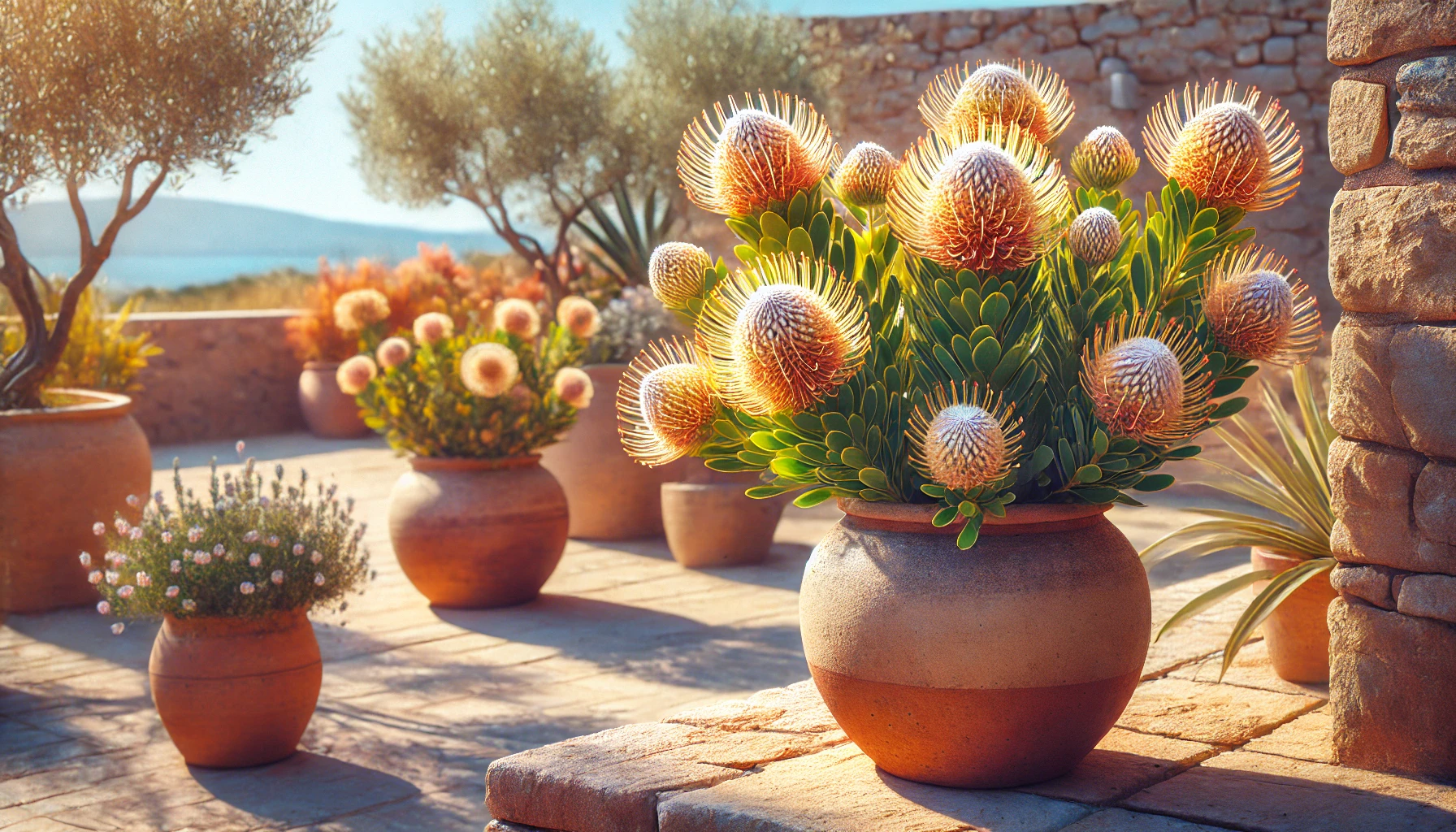
The Pincushion Protea (Leucospermum cordifolium) is a striking perennial known for its bright, spiky, spherical blooms that resemble a pincushion. Native to South Africa, it can grow up to 4 to 6 feet (1.2 to 1.8 meters) tall and wide. This exotic plant thrives in well-drained soil and sunny environments, making it a favorite for gardeners seeking a dramatic, low-maintenance addition to their outdoor spaces.
History and Ideal Growing Conditions
The Pincushion Protea has a rich history, originating in the unique fynbos biome of South Africa. It is well-adapted to dry, Mediterranean-like climates and thrives in regions with mild, wet winters and hot, dry summers. These plants prefer full sun and require well-drained soil, making them a perfect choice for rock gardens, xeriscapes, and coastal areas.
For ideal growing conditions, ensure your Pincushion Protea is planted in an area that receives at least 6 hours of direct sunlight each day. It tolerates USDA zones 9 to 11, so it is best suited for warmer climates. This plant can tolerate temperatures down to 40°F (4°C), but it thrives in the heat, handling temperatures up to 85°F (29°C) or more.
Toxicity and Pets
Unfortunately, the Pincushion Protea can be mildly toxic to pets, particularly cats and dogs. While it’s not commonly fatal, ingestion can cause stomach upset, vomiting, and diarrhea. To ensure your pets’ safety, consider placing these plants in areas less accessible to your furry companions.
Safe Alternatives for Pet-Friendly Gardens
If you’re looking for non-toxic alternatives, here are a few beautiful options that are safe for pets:
- Calendula (Calendula officinalis): Cheerful, easy to grow, and completely safe for pets.
- Snapdragon (Antirrhinum): Stunning blooms that pose no risk to pets.
- Zinnia (Zinnia elegans): Colorful and non-toxic, a perfect addition to any pet-friendly garden.
Best Practices for Caring for Pincushion Protea
The Pincushion Protea is relatively easy to care for, especially if you’re looking for a low-maintenance plant that stands out. Follow these guidelines to ensure it remains healthy and blooms abundantly.
Watering and Humidity
Pincushion Proteas prefer deep, infrequent watering. Once established, these plants are drought-tolerant and should only be watered when the top inch (2.5 cm) of soil feels dry. Avoid overwatering, as they are sensitive to root rot. In terms of humidity, they do best in drier climates with good air circulation.
Soil, Light, and Temperature
For soil, well-draining, slightly acidic to neutral soils (pH 5.5 to 7) work best. Sandy or loamy soils are ideal, as the plant doesn’t tolerate waterlogged conditions.
As for light, Pincushion Proteas thrive in full sunlight, requiring at least 6 hours of direct sunlight daily. Their ideal temperature range is between 50°F (10°C) and 85°F (29°C), and they can tolerate moderate frost but perform best in warm, sunny environments.
Fertilizing
Pincushion Proteas are sensitive to phosphorus, so avoid high-phosphorus fertilizers. Opt for a low-phosphorus, slow-release fertilizer in early spring to encourage blooming. Fertilizing once or twice a year is sufficient, as these plants do not require heavy feeding.
Common Problems and Remedies
Like any plant, Pincushion Proteas are susceptible to certain issues. Here are some common problems and solutions:
- Root Rot: Caused by overwatering or poorly drained soil. Ensure your soil drains well and avoid excess watering.
- Aphids or Spider Mites: If pests become an issue, use insecticidal soap or neem oil to keep infestations at bay.
- Leaf Spot: Typically caused by fungal infections in humid climates. Remove affected leaves and improve air circulation.
Invasiveness
The Pincushion Protea is not considered an invasive species. It grows well in controlled garden settings without displacing native plants.
Pruning Pincushion Protea
Pruning is essential for maintaining the shape and encouraging more blooms in the Pincushion Protea. The best time to prune is in late winter or early spring, just before the growing season begins.
Tools Needed
Use clean, sharp pruning shears or scissors for precise cuts. Make sure to sanitize your tools with rubbing alcohol or a bleach solution before and after pruning to prevent the spread of disease.
Identify Areas to Trim
Focus on removing dead or damaged branches, as well as any leggy growth. You can safely remove up to one-third of the plant to encourage more compact growth.
Deadheading
Regularly deadhead spent blooms to encourage new flowers. Remove the entire bloom stem down to the base.
Prune Leggy Growth
If your Pincushion Protea becomes leggy, prune back the stems by about one-third to promote fuller, bushier growth.
Remove Damaged or Diseased Leaves
Cut away any leaves that show signs of damage or disease to prevent further spread.
Shape the Plant
You can shape your Pincushion Protea by trimming back any uneven growth. This will keep the plant compact and neat.
Post-Pruning Care
After pruning, water your plant thoroughly and add a layer of mulch to help retain soil moisture and regulate temperature.
Propagation and Benefits
Pincushion Proteas can be propagated by seed or cuttings. Seeds should be sown in well-drained soil in early spring, while cuttings can be taken from mature plants in late spring or early summer. Both methods can be successful, though seeds may take longer to germinate.
The benefits of growing Pincushion Proteas go beyond their visual appeal. They attract pollinators like bees and butterflies, making them excellent for boosting biodiversity in your garden. Additionally, their drought tolerance makes them a sustainable choice for gardeners in dry climates.
Final Thoughts
The Pincushion Protea is an exotic, low-maintenance plant that brings dramatic color and texture to any garden. With its unique blooms and adaptability to different growing conditions, it’s a favorite among gardeners looking for something special. Keep pets in mind when placing the plant, and ensure it’s in a sunny, well-drained area for best results. Enjoy the long-lasting beauty of this fascinating plant!



